Shooting Krieghoff’s New K-80 Parcours – The Lightest K-80 Ever
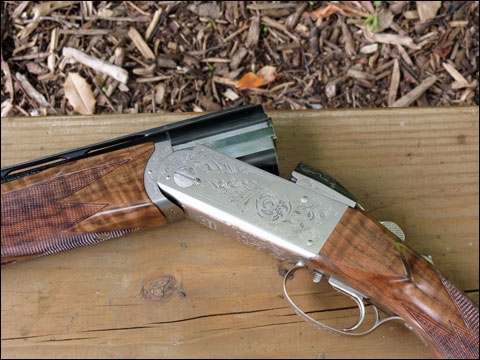
Caution: shooting the new Krieghoff K-80 Parcours will cause an overpowering case of shotgun lust.
By shaving approximately 10 ounces from the standard K-80 Sporter, Krieghoff’s stunning K-80 Parcours is a significant departure from the traditional K-80 that defined the Teutonic engineering credited with garnering countless skeet, trap and sporting clays gold medals worldwide for the past 25 years.
The Parcours program started in response to customers’ requests for a lighter version of the mighty K-80. The 12-gauge K-80 Parcours fills a niche in the Krieghoff line-up for a nimble, traditional clays gun designed with the upland hunter in mind that retains the legendary K-80 durability and is backed by Kreighoff’s celebrated service.
It was in fact Krieghoff’s UK division that initiated the push for a lighter K-80 that could successfully entice customers from the likes of the Perazzi MX8, Blaser F3 and Beretta DT10, which weigh approximately eight pounds each – or a minimum ¾ of a pound less than a K-80. By reconfiguring the barrels, stock and forend, the K-80 Parcours tips the scales at just shy of 8 pounds – placing it into the same weight class as the other three competitors.
 The new Krieghoff K-80 Parcours.
The new Krieghoff K-80 Parcours.
The K-80 Parcours was described as a “new flavor” of the K-80 platform by Dieter Krieghoff, the President and CEO of Krieghoff International and the fourth generation of the dynasty that has been building exceptional traditional hunting rifles and shotguns for 126 years.
In a conference room at Krieghoff International’s U.S. headquarters in Ottsville, Pennsylvania, Mr. Krieghoff explained that the K-80 Parcours marks the “internationalization” of the K-80 platform, with an eye on recreational shooters in Russia, India and China. He described Russia as one of the “top five” markets for the company, with nearly 25 active Krieghoff dealers. It’s no coincidence that the K-80 Parcours makes its appearance as emerging markets contribute a greater share to Krieghoff’s bottom line, especially with the company’s traditional hunting rifles.
The Parcours strategy is a nod to the major automobile makers that are building so-called world cars to capitalize on emerging economies. For example, Ford has the Escape, General Motors the Cruz and Chrysler hits the mark through Fiat’s acquisition. We believe that the Parcours is Krieghoff’s response to reaching affluent recreational shooters worldwide with a K-80 that delivers universal appeal.
That’s because we shot sporting clays with a K-80 Parcours prototype. Choked Modified and Improved Modified as per the fixed chokes specifications for the American version, the shotgun obliterated targets. There will be an option for Briley thin-wall, screw-in chokes that would broaden the versatility to skeet and appeal to shooters who prefer more open constrictions for Sporting Clays and five-stand.
The pointability of the K-80 Parcours proved remarkable. We expect that aspect of the gun’s performance to get even better when production models arrive in the U.S. with offset stocks for both right- and left-handed shooters to provide a more nuanced experience.
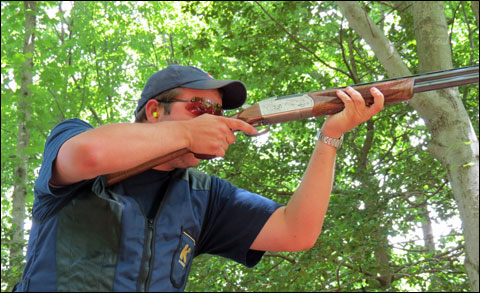 John Comerford, Assistant General Manager of Krieghoff International, shooting the Krieghoff K-80 Parcours at M&M Hunting Preserve & Sporting Clays.
John Comerford, Assistant General Manager of Krieghoff International, shooting the Krieghoff K-80 Parcours at M&M Hunting Preserve & Sporting Clays.
Krieghoff’s K-80 Parcours is the first shotgun we’ve taken up in a long time that effectively counters the arguments for new-generation, high-rib sporting models. The sight picture down its flat rib lets you identify the break point with inspired confidence. And the justifications for lower felt recoil with high-rib sporters was moot, since the K-80 Parcours produced no noticeable kick when firing Rio Target Loads of 1⅛ ounce, #8 shot rated at 1,200 feet per second. In effect, it seems that Krieghoff lightened the K-80 without sacrificing comfort.
Mr. Krieghoff said that customers already enamored with the original K-80’s probably won’t trade those guns for the sprightly Parcours. Instead, he believes existing owners will add a Parcours to their Krieghoff collections.
The company introduced the K-80 Parcours in late February 2012 at the British Shooting Show in Newark, England. The version coming to the U.S., however, will differ slightly by offering an adjustable comb as standard.
Krieghoff’s objective with the K-80 Parcours was to engineer a shotgun that addressed the criticism lodged against the weightier K-80s, while preserving the attributes of the premium K-80 brand. “The main opportunity for the Parcours is to overcome the weight objection,” Mr. Krieghoff said. “The Parcours is not just a way for us to sell more guns, but to expand the Krieghoff customer base. We listened to our customers.”
As a workhorse, the forged-steel, hand-fitted K-80 receiver has been tested over the past quarter century in skeet, trap and sporting clays where the guns are known to reliably withstand hundreds of thousands of rounds. Therefore, the K-80 receiver would remain intact on the Parcours. Krieghoff’s R&D shotgun team in Ulm, Germany instead concentrated on the barrels and wood in order to cut weight.
A set of 32-inch, 12-gauge barrels with 3-inch chambers and a tapered flat rib of 10-6mm for the K-80 Sporting model weigh 3 pounds, 13 ounces. Their floating-barrel configuration, where each barrel is separated, requires thick walls to handle the lack of side-rib stabilization while also preventing warping and vibration. The free-floating barrels include a hanger at the muzzles to adjust point of impact. The barrels swell at the muzzles to accommodate Krieghoff’s titanium chokes.
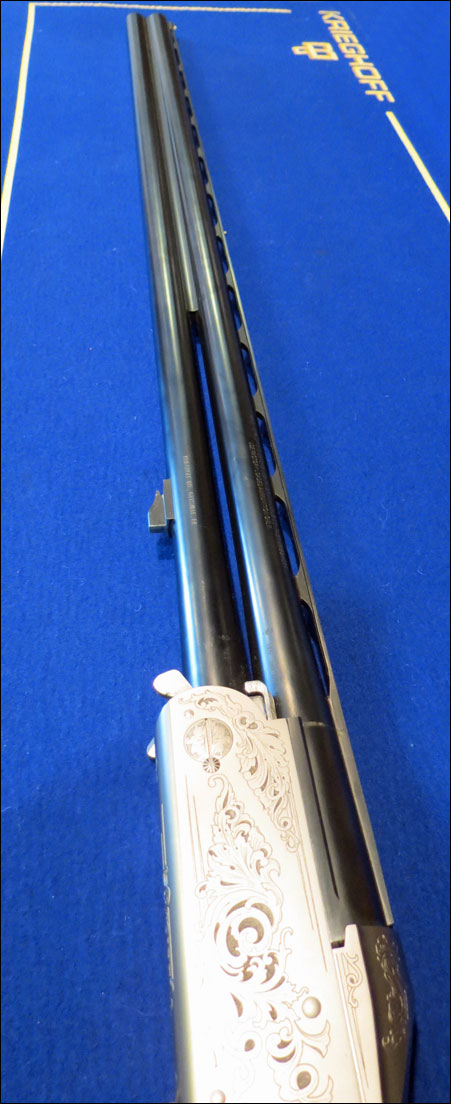 Notice where side ribs on the new Krieghoff K-80 Parcours barrels begin and end.
Notice where side ribs on the new Krieghoff K-80 Parcours barrels begin and end.
The Parcours barrels achieved lower weight through a comprehensive redesign. First, side ribs were added, allowing Krieghoff to trim barrel dimensions. The side ribs start at the muzzles and run about half-way down the barrels to just behind the forend.
Standard K-80 barrels have a bore of 18.6mm, outside diameter of 21.3mm and wall thickness of 1.35mm. The Parcours’ barrels feature the same bore and chamber length, but have an outside diameter of 20.5mm and wall thickness of .85mm. So the outside diameter of the Parcours barrels is 0.8mm thinner while the barrel wall thickness is 0.5mm smaller.
For the Parcours, Krieghoff eliminated the barrel hangers and the muzzle swell (making the Briley thin-wall chokes a factory option on the non-adjustable barrels). Even with the addition of side ribs, Krieghoff cut approximately 8 to 10 ounces from the K-80 Sporting barrels to yield a Parcours barrel weight of 3 pounds on the 32 inchers.
Additional weight savings on the shotgun were realized with the slimmest stock and forend ever produced by Krieghoff. The sum total of weight cuts gives you a K-80 that is just shy of 8-pounds – the lightest of them all.
 The beautiful Krieghoff KX-6 single-barrel trap gun.
The beautiful Krieghoff KX-6 single-barrel trap gun.
The K-80 Parcours continues the accelerated pace of shotgunning innovation coming out of Ulm. June 2011 saw the introduction of the KX-6 single-barrel trap gun. With its swooping ergonomic stock, black Carbo-Nitrided receiver and fully personalized adjustability, the KX-6 was a radical divergence from the out-going KX-5.
A high-tech adjustable butt plate made its debut on the KX-6. It allows for the tweaking of cast, drop and pitch via the adjustable comb wrench. Expect to see Krieghoff’s state-of-the-art butt plate as an option on the K-80 as well.
In early June 2012, Krieghoff introduced the K-20 Pro Sporter. Like the 12-gauge, K-80 Pro Sporter it features the high, adjustable rib and comb. We shot a prototype of the K-20 Pro Sporter in September 2011 and wrote that we “walked away with the indelible impression that it could rise to the ranks of the best high-rib sporting gun on the market – regardless of bore – period.”
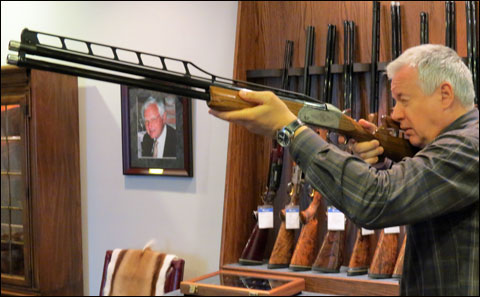 In the showroom of Krieghoff International, Dieter Krieghoff demonstrates the new trap-gun half-rib. Behind him is a photo of his late father, Heinz.
In the showroom of Krieghoff International, Dieter Krieghoff demonstrates the new trap-gun half-rib. Behind him is a photo of his late father, Heinz.
An ingenious trap-gun rib is ready to go on 32-inch and 34-inch barrels. It’s designed primarily for double trap. The idea for it came from the 2010 ISSF International Trap Double Event in Munich, Mr. Krieghoff explained. It’s based on the Unsingle, High-Post adjustable rib. Midway along the barrel, the rib angles down – giving shooters a clear view of the second target before they move the gun to it. You should see this on trap fields soon.
The new-product ramp-up is stimulating demand, which is most evident in the shop area of Krieghoff International. Eight gunsmiths are working full time on the preparation, repair and restoration of shotguns and rifles. A fresh shipment from Ulm awaits sorting. Components such as barrels, stocks, receivers and forends are on hand to customize each order before delivery to the dealer. A recent expansion of the building is ready for even greater growth as Krieghoff customers rebound from the economic slump.
 Part of the busy workshop at Krieghoff International.
Part of the busy workshop at Krieghoff International.
The push is to maintain the quality service with firearms excellence in a synergy that differentiates Krieghoff from its competitors.
“We are making Krieghoff a luxury brand, not just an expensive shotgun,” Mr. Krieghoff said. “We see it like a Purdey or a Holland & Holland, but no one else has it for the clay target market.”
Krieghoff now has the resources to turn around service orders within two weeks, he said. For Mr. Krieghoff, the responsiveness of the service department underscores the ideal of “earning the trust of our customers to write that kind of check,” noting that Krieghoff’s can range in price from $10,000 to more than $100,000. “Our guns cross the line into an investment that you like to use. It’s a pride of ownership. A lot of emotions come to play when customers buy a Krieghoff.”
Owning a Krieghoff means that you’ve arrived, so to speak. Examine a rack of shotguns at a club and the K-80 is immediately recognizable by its long receiver. As it turned out, the length of the receiver helped dampen recoil in the Parcours.
 Alex Diehl in the bluing room of Krieghoff International.
Alex Diehl in the bluing room of Krieghoff International.
With a length of 4¾ inches, it’s perhaps the longest over/under receiver in the industry. The receiver’s magnitude embodies the K-80’s design principle of centering the weight between the hands without the aid of supplemental add-ons that have become commonplace in the clays shooting world. According to Alex Diehl, Krieghoff International’s COO, the inherent balance of the long K-80 receiver serves to mitigate felt recoil in the Parcours.
We shot 100 rounds with the K-80 Parcours prototype at M&M Hunting Preserve & Sporting Clays in Pennsville, New Jersey. Accompanying me was John Commerford, Krieghoff International’s new Assistant General Manager. The targets had been set for the Northeast Regional Championship & National FITASC Championship a few weeks before, and rather than shoot the course in sequence we zigzagged around – choosing stations that would assess different handling characteristics of the Parcours.
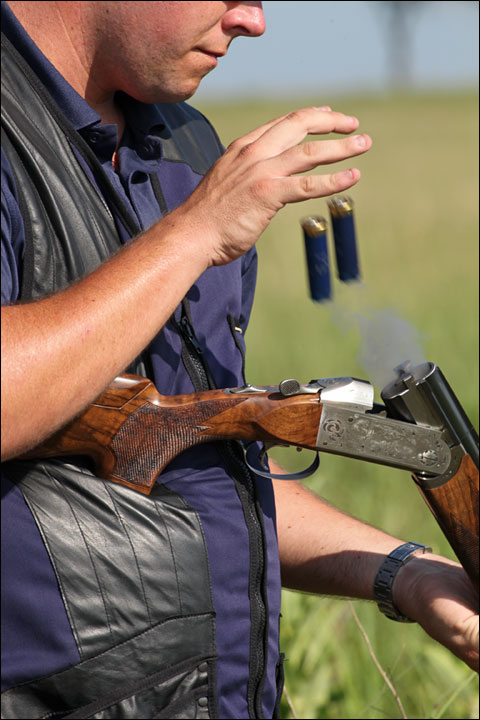 John Comerford with the Krieghoff K-80 Parcours.
John Comerford with the Krieghoff K-80 Parcours.
The first station presented a pair of easy outgoers: simply powdered them with the Parcours. The objective here was to gauge the pointability of the shotgun. Did it shoot where it was pointed? The six targets were center-punched. Good to go.
On the next station, we shot from an elevated platform. A couple of crossing targets of moderate speed were pulverized, including a true pair.
By the third station, we were on our way to the more challenging targets. This one threw a very fast left-to-right, long crosser and a quartering chandelle. I nailed the crosser every time but the chandelle took a while to figure out, although after about three attempts I started hitting it hard.
By now it became apparent that in addition to the Parcours’ accuracy, the lack of recoil played a central role in providing complete focus on the targets. The pistol grip and palm swell enabled a smooth mount and easy swing, facilitated by the overall balance of the shotgun. The mechanical trigger with 3½ to 4 pounds of pull that’s standard on the K-80 Sporter was crisp and responsive. We decided to take on the harder targets.
As we continued through the course, I shot Mr. Commerford’s K-80 Sporter that he uses in frequent competitions. It became immediately apparent that the Parcours was more to my liking, feeling easier to shoot, more nimble and responsive.
Ultimately, Krieghoff met its objectives with the Parcours.
Expect the Parcours to start in a price range similar to the K-80 Sporter. As with other Krieghoff shotguns, engraving and wood-grade options are available.
Irwin Greenstein is Publisher of Shotgun Life. You can reach him at letters@shotgunlife.com.
Useful resources:

Irwin Greenstein is Publisher of Shotgun Life. Please send your comments to letters@shotgunlife.com.


Comments